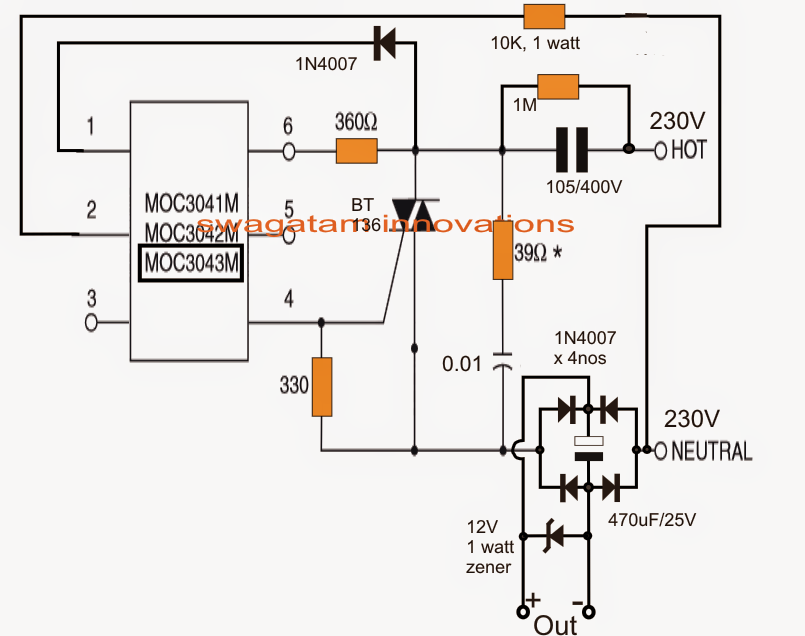The article explains a transformerless power supply circuit which works with zero crossing detection circuit to ensure a surge free output for the connected load.
An AC information without a zero crossing control can be a noteworthy reason for a surge current inrush in capacitive transformerless power supplies.
Today with the approach of refined triac driver opto-isolators, exchanging an AC mains with zero intersection control is no more an intricate undertaking, and can be essentially actualized utilizing these units.
The MOC arrangement triac drivers come as optocouplers and are authorities in such manner and can be utilized with any triac for controlling AC mains through a zero intersection identification and control.
How the Circuit Works
The MOC arrangement triac drivers incorporate MOC3041, MOC3042, MOC3043 and so on all these are practically indistinguishable with their execution characteristics with just minor contrasts with their voltage spces, and any of these can be utilized for the proposed surge control application in capacitive power supplies.
The zero intersection identification and execution are all inside handled in these opto driver units and one needs to just design the power triac with it for seeing the planned zero intersection controlled terminating of the coordinated triac circuit.
Before researching the surge free triac transformerless power supply circuit utilizing a zero intersection control idea how about we first see quickly in regards to what's a zero intersection and its included components.
We realize that an AC mains potential is made out of voltage cycles which rise and fall with changing extremity from zero to greatest and the other way around across the given scale. For instance in our 220V mains AC, the voltage changes from 0 to +310V crest) and back to zero, then sending downwards from 0 to -310V, and back to zero, this goes on constantly 50 times each second constituting a 50 Hz AC cycle.
At the point when the mains voltage is close to its immediate top of the cycle, that is almost 220V (for a 220V) mains info, its in the most grounded zone as far as voltage and current, and if a capacitive power supply happens to be exchanged ON amid right now, the whole 220V can be relied upon to leap forward the power supply and the related defenseless DC load. The outcome could be what we regularly witness in such power supply units.... that is moment smoldering of the joined load.
The above outcome may be generally seen just in capacitive transformerless power supplies in light of the fact that, capacitors have the characteristics of carrying on like a short for a fraction of a second when subjected to a supply voltage, after which it gets charged and acclimates to its right determined yield level
Returning to the mains zero intersection issue, in an opposite circumstance while the mains is nearing or intersection the zero line of its stage cycle, it can be thought to be in its weakest zone regarding current and voltage, and any contraption exchanged ON at right now can be required to be altogether protected and free from a surge inrush.
Along these lines if a capacitive power supply is exchanged ON in circumstances when the AC information is going through its stage zero, we can expect the yield from the power supply to be protected and drained of a surge current.
The circuit demonstrated above uses a triac optoisolator driver MOC3041, and is arranged in such a path, to the point that at whatever point power is exchanged ON, it turns ON and starts the joined triac just amid the initial zero crossing of the AC stage, and afterward keeps the AC switched ON typically for rest of the period until power is switched OFF and exchanged ON once more.
Alluding to the figure we can perceive how the minor 6-pin MOC 3041 IC is joined with a triac for executing the methods.
The data to the triac is connected through a high voltage, current constraining capacitor 105/400V, the load can be seen attached to the next end of the supply by means of an extension rectifier arrangement for achieving an unadulterated DC to the planned load which could a LED.
At whatever point power is exchanged ON, at first the triac stays exchanged OFF (because of an unlucky deficiency of the entryway drive) thus does the load joined with the extension system.
A food voltage got from the yield of the 105/400V capacitor reaches the inward IR LED through the pin1/2 of the opto IC.
This data is observed and prepared inside with reference to the LED IR light response.... also, as soon the fed AC cycle is distinguished reaching the zero intersection point, an inward switch right away flips and flames the triac and keeps the framework exchanged ON for whatever is left of the period until the unit is exchanged Now and again once more.
With the above set up, at whatever point power is exchanged ON, the MOC opto isolator triac verifies that the triac is started just amid that period when the AC mains is crossing the zero line of its stage, which thusly keeps the load flawlessly protected and free from the risky surge in surge.
